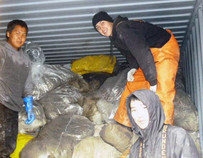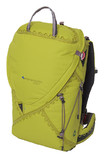New, first-class rucksacks, carpet tiles – and much more besides – are being made from old fishing nets
Along the West Coast of USA and Canada, we learned of ports where fishermen's used nets and fishing lines are accepted free of charge and taken to recycling companies. We asked ourselves what could possibly be made using old fishing nets. We met Paul King, a textile dealer in Vancouver, whose company, Kendor Textiles, is attempting to bring more sustainably-produced textiles to the market. Amongst other things, Kendor Textiles supplies its customers with textiles manufactured from recycled nylon. Fishing nets are often made from nylon. All we needed were a few more bits of information before we understood how old fishing nets are turned into almost brand-new and useful consumer items. Our explorer instinct kicked into gear, and whenever we had time and Internet access we made a few searches and managed to discover some fascinating facts and companies.
On our route, we noticed that there were recycling programmes especially dedicated to the collection of fishing nets and fishing lines along the West Coast of North America. Fishing nets and fishing lines pose a considerable direct threat both to marine animals and to shipping, which is why marine conservationists in North America have focussed their attention on them. Most fishing nets are made from nylon or HDPE. US studies have shown that the material properties of fishing nets made from nylon and HDPE do not change even after prolonged exposure to salt water and are suitable for recycling. Nylon seine nets are sometimes coated with other substances, such as tar, but these do not generally present many problems when it comes to recycling. Floating fishing lines used for crab pots and on parts of nets, by contrast, are mostly made of polypropylene (PP) and undergo some molecular changes as a result of exposure to salt water and sunlight, which poses problems when recycling. Fishing nets are basically easy to recycle because nylon is a thermoplastic, which can be melted down. The only problems with recycling fishing nets are:
- large, heavy nets are not easy to collect and transport and may therefore incur high transport costs in order to get them to a recycling plant
- nets are fibrous and tough and must be handled in specialized choppers to make them useable as raw material that can then be pelletized for recycling purposes
- nets contain floats, lead weights, lead line, and so on, that must be removed before recycling the net
- there are several types of nylon (usually nylon 6 and nylon 6,6), all of which have to be recycled separately
- in order for the nylon to be recycled, the recycling plant has to have a large quantity of a single type of nylon, e.g. nylon 6, and
- nets which have been in the water for a long time often cannot be recycled because they become so entangled and contaminated with organic contaminants such as algae, bones and shells which would have to be laboriously removed before the nets could be recycled
 Arnold Alfred, Paul Jenson, and Clint Teeluk from the low lower Yukon River in Alaska, load collected gillnets into a container for shipping (Photo courtesy: PSMFC & Kwik’pak Fisheries)
Arnold Alfred, Paul Jenson, and Clint Teeluk from the low lower Yukon River in Alaska, load collected gillnets into a container for shipping (Photo courtesy: PSMFC & Kwik’pak Fisheries)
Anyhow the Pacific States Marine Fisheries Commission (PSMFC) has worked with communities and tribal governments in North America to put some well-coordinated programmes into action which collect used nylon fishing nets at different depots before sending them to a central recycler in Seattle, WA, which acts as an intermediary. Skagit River Steel and Recycling receives used nylon fishing nets from Cordova, Dillingham, Naknek, Kenai, Juneau and along the Yukon River in Alaska, from Seattle and Bellingham in Washington, and from Astoria, Oregon. The company sorts the nets according to type, bales them, and markets them as 20-tonne bulk consignments. In recent years, customers have been found in Vietnam, Korea and China.
In Asia, these used fishing nets are melted after they have been cleaned, chopped into small pieces and pelleted. Recycled nylon has the same properties as virgin nylon manufactured from crude oil. Items which have been made from recycled nylon include bicycle seats, chair and luggage castors, tool handles, auto parts and electronics components, and many other things. Recently, used fishing nets have also been used in the manufacture of wear-resistant carpets and textiles.
Klättermusens award winning rucksack "Gna" made from recycled nylon (Photo courtesy of Klättermusen)
As the world's largest producer of nylon-6 fibres, the Korean company Hyosung is playing a leading role in nylon recycling. Hyosung recognises that more and more frequently, customers are asking for textiles made from recycled materials containing MIPAN regen. MIPAN regen is a new type of nylon filament manufactured from recycled industrial waste products, such as nylon fishing nets, BFC carpeting and nylon fabric. "Regen" is an abbreviation of the word "regenerated". MIPAN regen has been GRS (Global Recycled Standard) certified.One user of MIPAN regen is the Swedish outdoor product manufacturer, Klättermusen, which makes most of its rucksacks as well as the trousers in its Gere and Horg ranges from MIPAN regen. Klättermusen praises the fabric for its particularly robust and adaptable qualities, and the fact that it wears well even after years of demanding use, not to mention that it looks good and feels great.
Another company which has long been very much aware of its responsibility to-wards the environment is the world's largest designer and manufacturer of carpet tiles, Interface. Interface recently joined forces with the Zoological Society of London (ZSL), to address the growing problem of discarded fishing nets in some of the world's poorest coastal regions. The Net-Works partnership is launching a pilot project on the Danajon barrier reef system in the Philippines.
It seeks to address the environmental issue in an innovative way, and deliver social and commercial benefits at the same time. The partnership aims to establish a community-based supply chain for used fishing nets which will improve the livelihood of local fishermen, while providing Interface with an innovative source of recycled materials for its carpet tiles. Wear and tear on nets means that they have to be replaced frequently. Fishermen in developing countries often discard their nets on beaches or in the sea, where the nets could ostensibly remain for centuries. In Danajon Bank the problem is particularly acute, and it is estimated that the nets discarded in the space of just one year could cover the length of the Bank 400 times over. The fishermen, however, are often living in extreme hardship and are confronted by a declining number of fish stocks, and few opportunities to break the cycle of poverty and environmental degradation.
Nigel Stansfield, Chief Innovation Officer of Interface, explains: "Our Mission Zero goal is to eliminate our negative impact on the Earth by 2020, and phasing out our reliance on virgin raw materials is a big part of this. Partnering with ZSL and other experts, our objective is to convert "waste" from the environment – in this case, used fishing nets – into raw materials for our own manufacturing process. And what's really special is that at the same time we are aiming to create livelihood opportunities for some of the world's poorest coastal communities – communities which are often overlooked. This is a great example of organisations from different sectors coming together and pushing the boundaries – collaborating on a project with the potential to be good for the environment, for society and for the bottom-line."
The Net-Works initiative is embarking on a six-month pilot project on Danajon Bank which Interface believes is not only a global centre of marine shore fish biodiversity but also one of the most degraded coral reefs in the world. The pilot project will see Net-Works collaborate with local experts, fishing communities and the conservation group, Project Seahorse Foundation for Marine Conservation, with the aim of establishing a viable community-based supply chain for the used nets. Community groups will be responsible for the collection, processing and transport of the nets in return for payment which will be used to fund livelihood development schemes.
Dr. Nick Hill from ZSL says, "We know that this business model will be challenging to implement but we hope to show what a positive impact can be achieved when specialists in business, conservation and development combine their skills. One of our objectives is to create a sustainable business model with environmental, social and commercial benefit which can be replicated in other areas of the Philippines, and beyond."
Interface's business model is precisely the kind of pioneering example that we want to track down during the COPLARE journey, and which we would like the broader, international public to know about. Inter-face demonstrates that it is possible to tackle urgent environmental problems in a way which brings with it both social and economic benefits. Hyosung in Korea, Klättermusen in Sweden and Kendor Textiles in Canada, all contribute in an exemplary way to improving livelihoods to some degree in different parts of the world because they create the opportunity for their customers to purchase textiles made from recycled materials. We at COPLARE believe that by taking the lead and demonstrating their commitment, these companies will profit in more ways than one, and we urge everyone engaged in industrial and commercial activity to do likewise! We are happy to be able to share with you the discoveries we have made on our travels and to update you with these and many other examples. Keep following us!
Read more:
- http://www.interfaceflor.de/web/de/uber_uns/medienzentrum/presse_bereich/press-Interface-und-ZSL-kundigen-Zusammenarbeit-an-um-Umweltverschmutzung-an-Kusten-von-Entwicklungslandern-zu-begegnen
- http://www.hyosung.com/en/csr/green/eco_business.do
- www.klattermusen.se
- www.kendortextiles.com
- http://green.blogs.nytimes.com/2012/06/15/a-second-life-for-discarded-fishing-nets/
- http://marinedebrisblog.wordpress.com/2011/09/23/net-recycling-in-alaska/
PDF-Dokument [422.9 KB]





